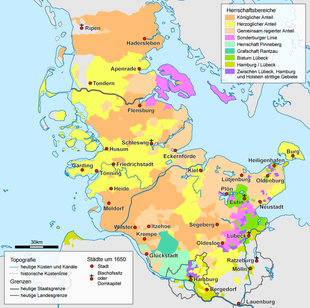Reign of Pinneberg
The dominion of Pinneberg was a secular territory in the area of today's district of Pinneberg and Altonas . It emerged in 1640 from the County of Holstein-Pinneberg and was added to the Prussian district of Pinneberg in 1867 .
history
When the last Schauenburg Otto V died in 1640 , the Danish King Christian IV occupied his Holstein possessions. The northern part he had to Duke Friedrich III. left by Schleswig-Holstein-Gottorf , the later county of Rantzau .
administration
The Danish administration meant a special position for the Pinneberg rule within the Duchy of Holstein . The Landdrost took over the administration of the rule . The office of Landdrosten was to be equated with the position of governor in the duchies.
The parish bailiffs and the bailiff took over as local officials the position of bailiffs under the Landdrosten. The Landdrost ensured the rights of Danish sovereignty and public peace and security. He was responsible for court and law and supervised all official matters.
The Pinneberg rule was divided into four administrative districts:
- The house and forest bailiwick of Pinneberg under a parish bailiff, who was also the bailiff of the entire rule and lived in Pinneberg . The villages of the parishes of Rellingen and Quickborn belonged primarily to the house and forest bailiwick .
- The Ottensen administration and the Hatzburg administration both with a parish bailiff who was also the beach bailiff and the district bailiff (rule) Uetersen with the bailiff who lived there as a local official. The boundaries of these bailiwicks did not, however, coincide with the actual parishes.
- The Herzhorn lordship , which was divided into the Herzhorn and the Sommerlandvogtei, as well as from the city of Altona , which was granted city rights in 1664.
Already under the rule of the Counts of Schauenburg and Holstein over Holstein-Pinneberg , from 1582 official registers were created in which legal transactions of the residents such as purchase contracts and marriage and inheritance contracts were documented. Based on the extensive stocks, economic developments and currency fluctuations such as B. which are occupied between 1612 and 1622.
Landdroste

- Hans Zacharias von Rochow (Rochau) 1639–1640
- Jasper von Oertzen 1648–1657
- Ernst Albrecht von Eberstein 1658–1665
- Friedrich von Vietinghoff (called Scheel) (1671–1680)
- Andreas Pauli from Liliencron –1683
- Conrad Biermann von Ehrenschild 1698–1703
- Martin Conrad Biermann von Ehrenschild 1698–1703
- Claus Hartwig von Perckenthin (Niclas Hartwig) 1704–1711
- Otto Carl von Callenberg 1719–1731
- Gebhard Ulrich von Perckentin 1732–1764
- Hans von Ahlefeldt 1764–1770
- Jürgen Ernst Scheel 1770–1784
- Theodosius Levetzau 1784-1817
- Ernst August von Döring 1817–1848
- Caspar Arnold Engel (interim) 1848
- Bernhard Rathgen 1848-1852
- Ludwig Nicolaus von Scheele 1852–1863
- Carl Wilhelm Wommelsdorff-Friedrichsen 1863-
- Adalbert Heinrich Friedrich von Baudissin 1865–1867 (in the transition phase from the rule of Pinneberg to the district of Pinneberg)
See also
Web links
- Pinneberg district archive: History of the Pinneberg district
- Official registers of the Pinneberg rule on the website of the City of Wedel (copies)
Individual evidence
- ↑ Inventory overview of the Pinneberg estate ( Memento from February 16, 2015 in the Internet Archive ), Schleswig-Holstein State Archives .
- ^ Emil Karl Richard Waschinski: Currency, price development and purchasing power of money in Schleswig-Holstein from 1226 to 1864 . Sources and research on the history of Schleswig-Holstein , Volume 26. K. Wachholtz, 1952
